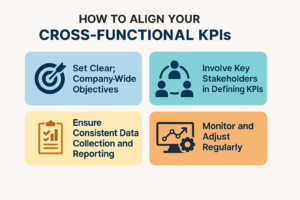In today’s fast-paced business world, alignment is the key to achieving sustained growth. One critical area that matters most is in your cross-functional KPI Alignment. When different departments—such as marketing, sales, finance, and operations—are all working toward different objectives or using disconnected performance indicators, it can result in inefficiencies, missed opportunities, and lackluster results. This is why aligning your cross-functional KPIs is essential for driving performance and achieving your strategic goals.
But how do you ensure that your KPIs are aligned, and what are the benefits of doing so? In this blog post, we’ll explore how to align your cross-functional KPIs for business success and the role they play in improving collaboration, decision-making, and performance.
Why Cross-Functional KPI Alignment Matters
When KPIs are aligned across all departments, your business operates as a unified force with a clear direction. The idea is that all teams are pulling in the same direction toward shared goals. Misalignment, on the other hand, can create confusion, inefficiencies, and conflict between departments.
Key reasons why KPI alignment is critical:
- Improved Collaboration: When your KPIs align, teams can work together more effectively, making it easier to share resources, expertise, and insights.
- Clearer Decision-Making: Aligned KPIs ensure that decisions are based on a consistent set of metrics, leading to more strategic and data-driven outcomes.
- Enhanced Performance Tracking: With consistent KPIs, you can easily track progress toward overarching business goals, identifying areas for improvement faster.
- Better Resource Allocation: By using a unified performance measurement system, companies can allocate budgets, personnel, and technology investments where they are needed most.
- More Accurate Data Utilization: When KPIs are aligned across teams, businesses can eliminate conflicting reports and instead rely on a single source of truth for data-driven decision-making.
In fact, studies show that organizations with aligned KPIs across teams see an increase in overall performance by over 30% in some cases (According to the Harvard Business Review: HBR).

How to Align Your Cross-Functional KPIs
Aligning KPIs across your organization requires strategy, communication, and ongoing monitoring. Here are five steps to help you align your cross-functional KPIs effectively:
1. Set Clear, Company-Wide Objectives
The first step in KPI alignment is to establish clear and measurable company-wide objectives. These objectives should be focused on the bigger picture and reflect the long-term vision of the organization. Once you’ve set these high-level objectives, break them down into specific goals for each department.
For example:
- Company Objective: Increase revenue by 15% in the next fiscal year.
- Sales Team Objective: Close 20% more deals in the next quarter.
- Marketing Team Objective: Increase lead generation by 30% over the next six months.
According to Forbes, companies that define clear objectives and align departmental goals see greater operational efficiency (Forbes).
2. Involve Key Stakeholders in Defining KPIs
To ensure your KPIs are truly aligned, involve key stakeholders from different departments when defining what success looks like. Cross-functional collaboration at this stage helps identify common performance metrics that are relevant to each team.
For instance, marketing might track leads generated, while sales might focus on the conversion rate. However, both teams should be working toward the same end goal: driving revenue. Having input from various functions ensures that all perspectives are considered, and alignment is achieved (as noted by McKinsey: McKinsey).
3. Ensure Consistent Data Collection and Reporting
Data is the backbone of accurate and meaningful KPIs. Without consistent data collection, businesses can struggle to measure performance effectively. Establish company-wide standards for:
- Data Accuracy: Ensure that all departments use the same criteria for tracking and reporting metrics.
- Standardized Reporting: Use a centralized dashboard or data visualization tool to present KPIs consistently.
- Data Validation Processes: Implement automated validation checks to prevent discrepancies between different reports.
- Common Definitions: Align terminology across teams to avoid confusion (e.g., defining what constitutes a “qualified lead”).
Research from Gartner suggests that organizations with standardized data reporting practices improve business decision-making efficiency by up to 25% (Gartner).
4. Monitor and Adjust Regularly
KPI alignment isn’t a one-time exercise. It requires ongoing monitoring and adjustments as business conditions evolve. Regularly assess your KPIs and their impact on overall business performance. Use data to analyze progress and address any gaps or misalignments that may arise.
For example, if the sales team isn’t achieving its targets despite marketing generating high-quality leads, it could signal a misalignment in the process or a need for better training. According to Deloitte, continuous monitoring and adaptation of KPIs can improve business agility and responsiveness (Deloitte).
5. Leverage Technology for Tracking
To effectively track and align KPIs, utilize KPI management and performance-tracking tools. Platforms like Tableau, Power BI, and Google Analytics allow teams to visualize progress, identify trends, and make data-driven decisions in real time. Technology-driven performance tracking can enhance KPI accuracy and improve decision-making speed (TechCrunch).
Common KPI Misalignments and How to Avoid Them
Even with the best intentions, KPI misalignment can still occur. Some common pitfalls include:
- Varying Metrics Across Teams: When different teams track different metrics that don’t roll up to overarching company objectives, performance can appear fragmented and confusing.
- Lack of Communication Between Teams: Without regular communication, teams may develop siloed views of success, leading to conflicts or duplication of efforts.
- Failure to Reassess KPIs Regularly: Businesses that fail to adjust their KPIs to changing market conditions risk falling behind competitors.
By avoiding these pitfalls and proactively aligning your KPIs, your organization can foster collaboration, enhance performance, and drive meaningful results.
Final Thoughts
Cross-functional KPI Alignment is essential for ensuring that your organization operates cohesively and efficiently. By setting clear objectives, involving stakeholders, standardizing data collection, continuously monitoring progress, and leveraging technology, businesses can maximize their performance and stay competitive in today’s fast-paced environment.
Ensuring Cross-functional KPI Alignment is not a one-time effort but an ongoing process. Companies that prioritize it will reap the rewards of improved collaboration, streamlined decision-making, and sustained growth (Harvard Business Review).

